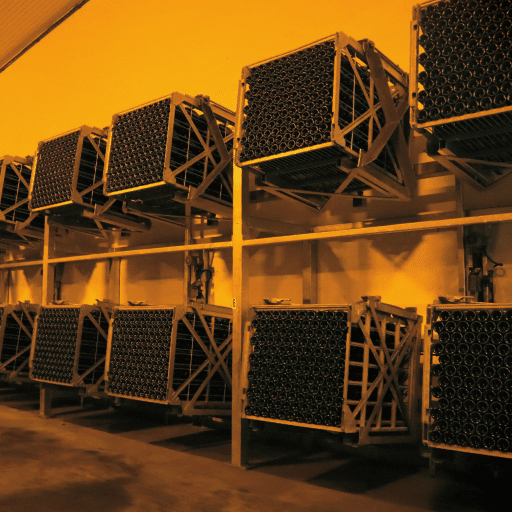The traditional method, or méthode champenoise, is the unique process for making champagne. Riddling is a key stage in this method. It takes place following the second fermentation in the bottle, after a minimum ageing period of 15 months. It consists of gradually bringing the deposit back into the neck of the bottle so that it can be removed when the wine is disgorged.
A brief history
Over the years, champagne producers have refined the riddling technique. From the beginnings of effervescence to the advent of mechanical riddling with the deployment of the Gyropalette®, riddling has gone through a number of milestones before being fully mastered.
From the 18th century onwards, champagne producers used a sandbox in which they placed the bottles, gradually, bringing them upright. This method was later replaced by the riddling table, imagined by Madame Clicquot in 1818.
Later, the riddling rack was adopted throughout the Champagne region, leading to the creation of the riddling profession, which is called a “remueur”. The first mechanical riddling machines appeared in the 1960s. This was the case with the Pupimatic, on which the winemaker placed the bottles one by one in buckets.
In 1968, Claude Cazals and Jacques Ducoin invented the pallet crate, for handling a large batch of bottles. The first Gyropalette® GH was marketed in 1973. These first automatic machines enabled batch riddling, which revolutionised the technique. At the same time as the Gyropalette® was taking off, other riddling mechanisms were being developed, such as the Champarex, Remupal and Rotopal.
Then, the GYROPALETTE® was perfected to enable more bottles to be turned and tilted in a minimum of time and space. As a result, winegrowers can now purchase equipment capable of riddling 2016 bottles at the same time with a Gyropalette® Quadra, for example, for a floor area of less than 5m².
Riddling process
The specificity of the traditional method is that the champagne is vinified directly in the bottles. The bottles are filled with wine, to which yeast and additives are added, and then placed in the cellars for the ageing stage. This second fermentation in the bottle, known as the “prise de mousse”, allows the bubbles to appear and gives the wine all its finesse.
After this long rest in the cellars comes the riddling phase. The aim of this stage is to remove the deposit (yeast and additives) from the bottle. The technique consists of alternating rotation and tilting movements with rest periods, in order to gradually gather the deposit towards the neck. In this way, the bottles gradually move from a horizontal to a vertical position. These rotation and tilting movements gradually collect the deposit in the bottles. The rest periods between movements allow the deposit to flow slowly towards the neck of the bottle. A riddling programme can contain up to 100 turning and tilting operations – known as “tenues de remuage” (“riddling steps”) – and last from 3 to 9 days.
At the end of the riddling process, the bottles are upright and all the sediment is collected in the neck of the bottle. The manufacturer then dips the bottle necks into an ice tray, with a solution at -20°C. An ice cube forms, trapping the deposit. The deposit is then removed by disgorging.
Manual and mechanical methods
Manual riddling is the traditional method used to riddle bottles of sparkling wine. The bottles are placed horizontally on a wooden desk. The “bottle turner” turns and tilts the bottles by hand until they are almost vertical. Although this method is effective, it is long and tedious.
Today, Gyropalettes® have replaced the desks in most wineries producing Champagne or sparkling wines. The automatic riddling machine offers a number of significant advantages over the traditional riddling desk.
- The first advantage is that it saves time. A Gyropalette® can make all the operations in a few days (between three and nine days). However, riddling on a rack takes several weeks.
- The gain in precision is a second significant advantage. The Gyropalette® can turn the bottles by 16ths of a turn. Manual riddling can be done in 8ths of a turn. What’s more, tilting is done to the nearest degree on an automatic equipment. Tilting can only be done in tenths of a degree on a console.
- In addition, the Gyropalette® saves a considerable amount of space. A single-cage unit can handle 504 bottles at the same time, taking up 2m² of floor space. A standard-sized desk can handle 120 bottles on a similar surface.
In conclusion, riddling plays an essential role in expressing the different terroirs of the Champagne region. However, the traditional method is not exclusive to the CHAMPAGNE region. Other sparkling wine-producing regions such as Burgundy, Alsace and the Jura. Some regions in Spain, Italy and the United States also use riddling in their winemaking process. This specific technique, combined with the expertise of the winemakers and the typical characteristics of the terroirs, contributes to the richness and diversity of sparkling wines throughout the world.
